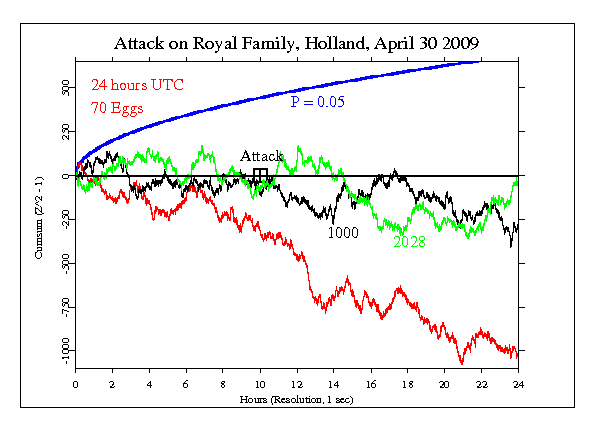|
This is an exploratory analysis done by request on January 15 2010 for
an event that took place in April 2009. Apparently a
berserker attempted to crash his car into the open bus
carrying the Dutch royal family in a parade on Queensday.
Here is a description from web reports:
Five people (other reports say eight) were killed and more than
a dozen wounded on
Thursday, "Queensday" , when a driver hurtled his
car into a crowd at a parade in the town Apeldoorn, the
Netherlands, narrowly missing an open bus carrying Queen
Beatrix and members of the Royal Family.
Dutch officials said the man had "acted
deliberately" but they ruled out links with a terrorist
group. "The driver is suspected of trying to attack the
royal family," a spokesperson for the Dutch police said,
not giving additional details as to a possible motive.
Koninginnedag or Queen's Day is a national holiday in the
Netherlands, the Netherlands Antilles, and Aruba on 30 April
or on 29 April if the 30th is a Sunday. Queen's Day
celebrates the birthday of the Queen of the Netherlands and
is supposed to be a day of national unity and "togetherness"
(Dutch: saamhorigheid). The tradition started on 31 August
1885 on the birthday of Princess Wilhelmina, later Queen
Wilhelmina. Since 1949, after the ascension of Queen
Juliana, Queen's Day is Queen Juliana's birthday on 30
April. Although Queen Beatrix's birthday is on 31 January,
she officially celebrates her birthday on 30 April.
Queen's Day is known for its "freemarket" (Dutch: vrijmarkt)
all over the country, where everybody is allowed to sell
things in the streets. Other activities during Queen's Day
are children's games, individual musical performances, and
music concerts. The night before Queen's Day is celebrated
too in some cities, and this is called Queen's Night (Dutch:
Koninginnenacht). The largest celebration of Queen's Day is
in Amsterdam, Queen's Night in The Hague and Queen's Dance
(Dutch: Koninginnedans) in Rotterdam. During the
celebrations as reference to the colours of the House of
Orange-Nassau, people dress in the colour orange, which is
sometimes called "orange craze" (Dutch: oranjegekte).
This analysis was done in response to an email request from a
colleague in the Netherlands made 14 Jan 2010. It is an
exploration, not part of the formal series.
Last year there was an attack on our royal family. A number
of the public
died including the attacker. This was broadcast live on TV
and created a
shock in the Netherlands.
I don't think it did much in other countries.
The date was April 30 and the time was 12:00 local time.
The RNG's which were closest are 1000 and 2028.
Is it possible to run a formal analysis for me? For the
whole network and
for the closest rng's?
I used previous events of generally similar type as a model.
They have mostly been 3 or 4 hours in length, and I specified 4
hours for the Queensday event, from 12 noon to 4pm local (10:00 to
14:00 UTC). The first graph shows this period, and the
second graph show the context of the full UTC day. The data
from the whole network shows reduced network variance for
much of the day, and for the 4-hour period, this is also the
case. The departure from expectation corresponds to Z =
-2.285. Neither of the individual eggs shows a strong
departure.

Results from individual events should not be overinterpreted
(see note below) but the departure from expectation
for the network is strong enough to be nominally
significant. It is more interesting, however, to note that
of 9 generally similar events, 5 have a substantial
negative deviation, like this one.

It is important to keep in mind that we have only a tiny
statistical
effect, so that it is always hard to distinguish signal from
noise. This means that every "success" might be largely
driven by chance, and every "null" might include a real
signal overwhelmed by noise. In the long run, a real effect
can
be identified only by patiently accumulating replications of
similar analyses.
|